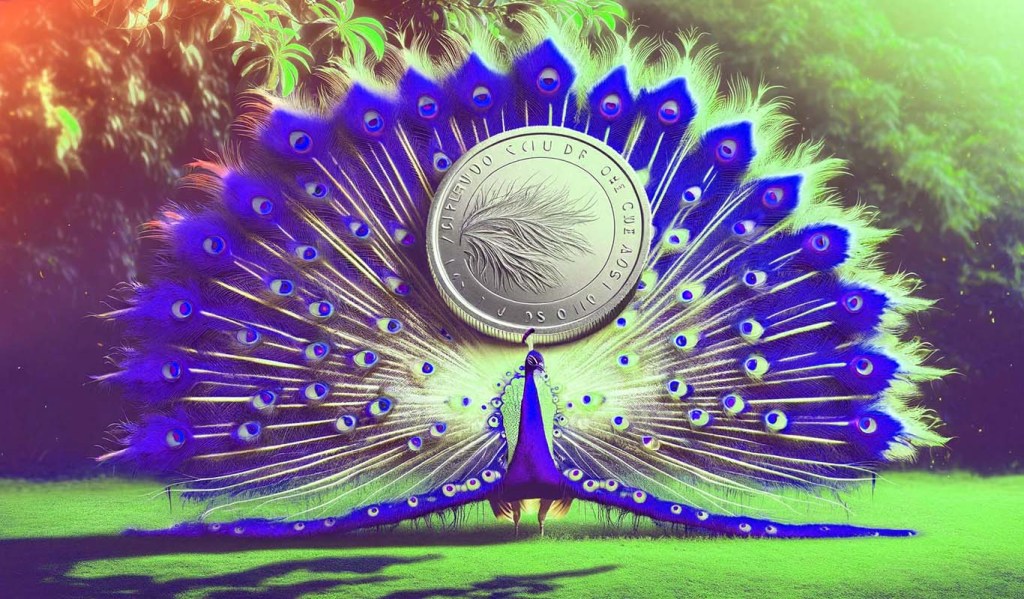
A closely followed crypto trader is bullish on one under-the-radar layer-1 project that has lagged behind other altcoins. Pseudonymous trader and analyst Inmortal tells his 212,000 followers on the social media platform X that he’s got his eye on Constellation (DAG), a blockchain that uses Directed Acyclic Graph technology. Inmortal says that DAG’s market structure […]
The post Crypto Trader Bullish on One ‘Unpumped’ Altcoin, Updates Outlook on Bitcoin (BTC) and Ethereum (ETH) appeared first on The Daily Hodl.

A widely followed analyst thinks that massive gains are ahead for a new decentralized finance (DeFi) altcoin. Pseudonymous analyst Inmortal tells his 209,300 followers on the social media platform X that the governance token of the Solana (SOL)-based decentralized exchange aggregator Jupiter (JUP) looks primed for a parabolic surge. Inmortal shares a chart suggesting that […]
The post Analyst Predicts Over 200% Rally for DeFi Altcoin, Updates Forecast on Chainlink and One Additional Coin appeared first on The Daily Hodl.

A closely followed crypto strategist believes that one small-cap layer-0 altcoin project is primed for a breakout. Pseudonymous analyst Inmortal tells his 207,600 followers on the social media platform X that scaling solution Constellation (DAG) is in an uptrend after bouncing off a key level at $0.05 following a long accumulation phase. “I like DAG […]
The post Trader Says Under-the-Radar Layer-0 Altcoin Ready for Expansion After Long Accumulation Phase appeared first on The Daily Hodl.

"Fantom will become the youtube/twitch of blockchain platforms," commented ecosystem architect Andre Cronje.
According to a new proposal dated Dec. 1, directed acrylic graph network Fantom seeks to implement an affiliate program for its decentralized application, or dApp, developers with network gas fees. To fund this venture, the Fantom community has proposed slashing the protocol's current FTM token burn rate from 20% to 5%. In supporting the proposal, Fantom developers wrote:
"We take what works in web2 and restructure it to fit the network's priorities, which means taking the ad monetisation model and extending it to gas monetisation for performing dApps that manage to attract a steady stream of users."
The development team further elaborated that Fantom’s Opera network [native dApp builder] "is not directly competing against Youtube or Twitter," but seeks to "attract and retain high-grade talent continuously" in the Web 3.0 space. To qualify for the potential incentive, dApps must have recorded 1,000,000 or more transactions and have spent three months or above on the Fantom Opera network. Upon approval, developers can then claim 15% of the total gas fees spent on their dApp.
New governance proposal: dApp Gas Monetization Program
— Fantom Foundation (@FantomFDN) December 1, 2022
This gas monetization program will seek to reward high-quality dApps, retain talented creators, and support #Fantom’s network infrastructure.
Read the full detailshttps://t.co/GVBAWXqXBO
However, the Fantom Foundation said that it "reserves the right to halt any payment stream indefinitely for any reason, including if fraudulent user activity is suspected or if the Foundation believes it is in the best interests of the Fantom ecosystem." Currently, a total of 8.36 million FTM tokens have been burned since the Fantom mainnet went live in 2019. Voting for the proposal is ongoing and requires a minimum of 55% turnout from FTM token holders to pass.

“Assembly addresses the limitations of current scaling solutions by using the feeless base layer of IOTA as an immutable trust anchor and as a trustless bridge for feeless interoperability of smart contracts,” said Schiener.
On Friday, Assembly, a decentralized layer one smart contract network built within the IOTA ecosystem, announced it had raised $100 million from private investors, including LD Capital, HyperChain Capital assembly, and Huobi Ventures.
The project stated that the funds will be used to accelerate the development of decentralized finance protocols, nonfungible tokens, and play-to-earn crypto games.
IOTA is a blockchain designed for facilitating internet-of-things transactions. Its proprietary technology consists of a system of decentralized acyclic graphs that can connect to one another in multiple vectors as opposed to in-series as with a regular blockchain. As a result, one new block can validate two other blocks, leading to self-sustainable transaction verification. This allegedly leads to the complete elimination of transaction fees and minimal energy cost.
The Assembly mainnet is currently scheduled to launch in early 2022 with a large community focus. 70% of its native ASMB tokens are reserved for developer incentives, community-governed decentralized autonomous organizations, and grant programs.
Meet $ASMB, a token to fuel innovation and growth. The vast majority of tokens are designated to ignite #Assembly's ecosystem growth and to reward the @iota community.
— Assembly (@assembly_net) December 9, 2021
Visit: https://t.co/ULLTR84ZKN pic.twitter.com/fycCeywW94
In a statement to Cointelegraph, Dominik Schiener, co-founder and chairman of the IOTA Foundation, claimed that there are too many Ethereum Virtual Machine, or EVM, blockchains stating:
“Ultimately, all of them will face the same problems with fees, scalability, and interoperability. Most of them will fail in the long term as they offer nothing unique.”
When asked about the uniqueness of the Assembly blockchain, Scheiner feels that it all comes down to flexibility:
“Each smart contract chain can be fully customized to the project's needs. In addition, Assembly is already fully EVM-compatible, and has support for WASM [WebAssembly], plus Go, Rust and TypeScript as optional smart contract languages.”
Billionaire investor Stelian Balta, founder of HyperChain Capital, said:
We always needed a feeless, highly scalable network for developers to build highly scalable apps in the crypto ecosystem. Assembly does that. They have been pioneers in the crypto ecosystem since 2015, and we are confident in their experience and their vision for the next decade.

A simple guide to explain what a directed acyclic graph (DAG) is in cryptocurrencies, how it is used and how it works.
Blockchains and DAGs both record transactions on a distributed ledger, albeit through different means.
Below is a quick comparison of the two in terms of benefits and drawbacks:
At the end of the day, deciding on which model to use will depend on one’s business objectives. As we discussed, each model has its strengths and weaknesses, and either one can be more applicable depending on your requirements.
DAG can be seen as a viable alternative to blockchain, although it still requires further fine-tuning. The DAG model seeks to improve common issues with blockchain technology such as cost, speed and scalability.
Technically, both technologies record transactions on a digital ledger and work towards the same goal. The differentiating factor between the two of them is mainly the structure each model uses to store data.
It used to be unimaginable to think of cryptocurrencies without thinking of blockchain. With the DAG model, however, several cryptocurrencies have already been built using this technology.
Some examples are Obyte, IOTA, and Nano, to name a few. Although still relatively new, the DAG framework shows great potential. As mentioned, some projects have already used it successfully. The most well-known ones are:
Obyte or ByteBall is a cryptocurrency that is completely independent of the blockchain, having implemented the DAG framework. However, Obyte transactions still have a fee.
This is because the Obyte network utilizes a validator system that allows for double-checking of transactions. It makes use of a consensus algorithm that relies on witnesses. These witnesses are trusted and reputable users who act as validators.
Obyte also supports untraceable transactions, as well as unreachable contracts.
Internet of Things Applications, or IOTA, implemented its ‘blockless blockchain’ network in 2016. The idea behind IOTA is that all users effectively become miners. To validate one transaction, for example, a user has to verify two transactions.
IOTA uses a network composed of nodes and tangles, or groups of nodes, that serve to make the validation process faster and more efficient.
All users contribute a small amount of power for the network’s maintenance, and everybody participates in executing consensus as well. This allows the network to be highly decentralized and scalable at the same time.
Transactions have near-zero fees; hence, IOTA is considered a cost-effective alternative cryptocurrency for micro-payments.
Nano is also a cryptocurrency operating on the DAG system. Nano has independent blockchains connected by nodes and is called block-lattice technology. Technically, it’s a mix of DAG and blockchain.
Every user has an individual wallet and a blockchain. Only the user can execute changes on their own wallet/blockchain. Transactions are completed once the sender and receiver both perform operations on their respective blockchains.
Nano offers zero transaction fees, as well as high transaction speeds to its users.
The DAG model seeks to address two perceived weaknesses of blockchain technology, namely, decentralization and scalability. It seeks to improve security and usability as well.
How so?
With the elimination of blocks, the DAG model won’t require mining. This means less power is required to support the network. DAGs also have several advantages, such as:
Currently, though, the use of DAGs in crypto is still in the early stages. Unlike blockchains, they are still not fully decentralized. As such, they are primarily used for getting networks started, and not yet as a system that can be used to build a stable network.
As mentioned, a directed acyclic graph is more efficient at data storage. Its structure is tree-like, with interconnected nodes as its ‘branches.’
Since each node can have more than one parent root, the model allows for more transactions to be validated simultaneously. This is because users do not have to wait for transactions to complete before processing a new one.
So in a directed acyclic graph, each new transaction has to reference previous transactions before getting accepted into the network. This is no different from how blocks on a blockchain also reference previous blocks. The rationale behind this is that a transaction can only be successfully confirmed when it is referenced by another transaction, and so on.
In a DAG, each vertex represents a transaction. There are no blocks, so mining is also not required. Transactions are built on top of one another instead of gathering them into blocks. Then, as previously mentioned, proof-of-work tasks are done whenever a node submits a transaction, to validate prior transactions and avoid spam.
By principle, new transactions are built on top of older ones in a DAG-based cryptocurrency. The main difference with blockchain is that in a DAG, multiple transactions can be referenced, instead of just one at a time.
Some systems have an algorithm that selects ‘tips’ or transactions to build on based on accumulated weight (or the number of confirmations leading up to the tip).
Double-spend protection in DAGs works with nodes confirming older transactions by assessing a path tracing back to the DAG’s first transaction. This confirms whether or not the sender has sufficient balance. Should a user build on an invalid path, then that transaction is at risk of being ignored.
Conflicts resulting from multiple paths are resolved via a selection algorithm that favors tips that have a heavier accumulated weight.
A directed acyclic graph or DAG is a data modeling or structuring tool typically used in cryptocurrencies.
Unlike a blockchain, which consists of blocks, directed acyclic graphs have vertices and edges. Thus, crypto transactions are recorded as vertices. These transactions are then recorded on top of one another. Similar to a blockchain, however, transactions are also submitted to the DAG via nodes. Proof-of-work (PoW) tasks are required of nodes to submit a transaction.
Simply put, whereas a blockchain system looks like a chain, DAG’s system looks more like a graph. The DAG model is currently seen in the industry as a possible substitute for blockchains in the future due to its efficiency in data storage and processing of online transactions.
The DAG model is seen as a possible solution to the current decentralization issue in crypto. With this model, miners will not have to compete for new blocks to add to the chain.
With nodes developed simultaneously, transactions can likewise be processed faster. Developers are eyeing DAG as a better, more secure solution that can improve a network’s usability once it becomes more scalable.